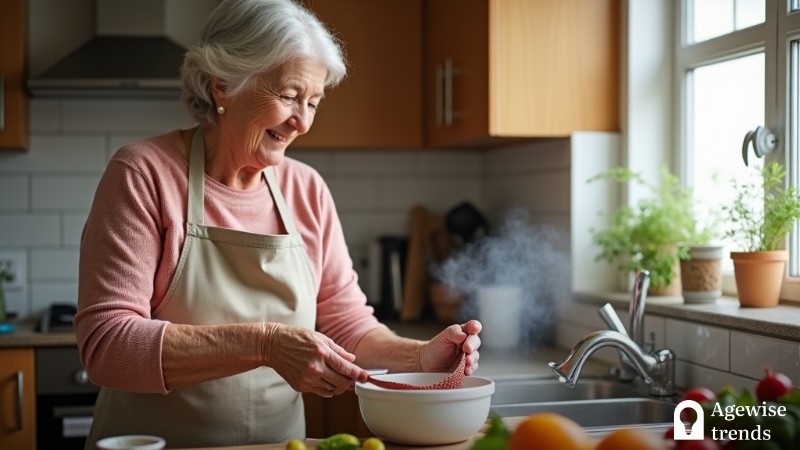Foodborne illnesses affect millions annually, with 48 million cases in the U.S. alone. These illnesses occur when food is contaminated by harmful bacteria, viruses, parasites, or toxins.
While many cases are mild, they can cause serious complications for children, the elderly, and those with weakened immune systems. Safe food practices—such as maintaining hygiene, preventing cross-contamination, cooking to proper temperatures, and refrigerating perishable items promptly—can help prevent most foodborne illnesses.
Key Takeaways
Preventing foodborne illnesses requires proper hygiene, careful handling of ingredients, and safe cooking practices to reduce the risk of contamination.
- Maintain cleanliness in the kitchen by washing hands with soap and water for at least 20 seconds before preparing food.
- Use a food thermometer to ensure proper cooking temperatures: beef, pork, veal, and lamb to 145°F; fish to 145°F; ground meats to 160°F; poultry to 165°F; and leftovers to 165°F.
- Refrigerate perishable foods within 2 hours (1 hour if above 90°F) and store leftovers in shallow containers to prevent cross-contamination.
Common causes and symptoms of foodborne illness
Food poisoning symptoms, like abdominal cramps, nausea, vomiting, diarrhea, and fever, often resemble other illnesses. If multiple people have the same symptoms after eating the same food, foodborne illness is likely.
Certain foods are more prone to contamination, such as raw or undercooked meat, poultry, seafood, unpasteurized dairy, raw produce, seeds, sprouts, honey (dangerous for infants), and improperly stored baby formula.
Bacteria and viruses cause foodborne illnesses. Salmonella is found in raw meat, eggs, and unpasteurized milk, with symptoms appearing 6 to 48 hours later. E. coli is linked to undercooked beef, raw produce, and contaminated water, with symptoms appearing 2 to 5 days later. A November 2024 outbreak was linked to contaminated carrots.
Staphylococcus aureus (Staph) is transferred by infected food handlers and produces toxins that cooking can’t destroy, with symptoms appearing within hours and lasting a day. Clostridium perfringens thrives in food left at unsafe temperatures, often in cafeterias, with symptoms starting 6 to 24 hours later.
Campylobacter is found in raw chicken, unpasteurized milk, and contaminated water, causing diarrhea and fever within 2 to 5 days. Shigella spreads through contaminated food, water, and poor hygiene, with symptoms appearing 1 to 3 days after exposure. Botulism, caused by toxins in improperly canned food and honey, can lead to muscle weakness and breathing issues, lasting weeks or months without treatment.
Safe food handling practices
Food safety begins with proper hygiene and careful handling of ingredients. Many harmful bacteria and viruses spread through contaminated hands, surfaces, and utensils.
Maintain cleanliness in the kitchen
Wash your hands with soap and water for at least 20 seconds before preparing food, after handling raw meat, poultry, seafood, or eggs, and before eating. This helps prevent bacteria from spreading.
Clean all kitchen surfaces, utensils, and cutting boards with hot, soapy water after each use to avoid cross-contamination. Rinse fresh fruits and vegetables under running water to remove contaminants. If you have cuts or sores on your hands, wear gloves to prevent bacteria transfer. Avoid preparing food when you’re sick, especially with symptoms like nausea, vomiting, or diarrhea, to prevent spreading illness.
Prevent cross-contamination
Cross-contamination occurs when harmful bacteria from raw meat, poultry, seafood, or eggs spread to ready-to-eat foods. To prevent this, store raw meat in sealed containers away from other foods in the refrigerator.
Use separate utensils and cutting boards for raw meat and fresh produce to avoid bacterial transfer. It’s also important to never wash raw chicken, as doing so can spread bacteria to sinks, countertops, and other kitchen surfaces. If you do choose to rinse chicken, be sure to clean and disinfect the surrounding area immediately to minimize the risk of contamination.
Cooking, storing, and reheating food safely
Use a food thermometer to ensure proper cooking: beef, pork, veal, and lamb to 145°F with a 3-minute rest; fish to 145°F; ground meats to 160°F; poultry to 165°F; and leftovers to 165°F, stirring when microwaving for even heat.
Refrigerate perishable foods within 2 hours (1 hour if above 90°F). Keep the fridge at 40°F or below and the freezer at 0°F or below. Store leftovers in shallow containers and never thaw food at room temperature—use the fridge, cold water, or microwave.
Simple habits for a safer kitchen
By following food safety steps like cleaning, preventing cross-contamination, cooking thoroughly, and proper storage, families can reduce the risk of foodborne illnesses. With millions of food poisoning cases annually, preventive measures are crucial.
Recognizing symptoms and common contamination sources, such as undercooked meats and raw produce, can keep your household safe. Simple habits like washing hands, using a thermometer, and refrigerating food promptly can make a big difference. Practicing essential kitchen safety tips ensures you’re prepared to prevent illness and protect your family.















